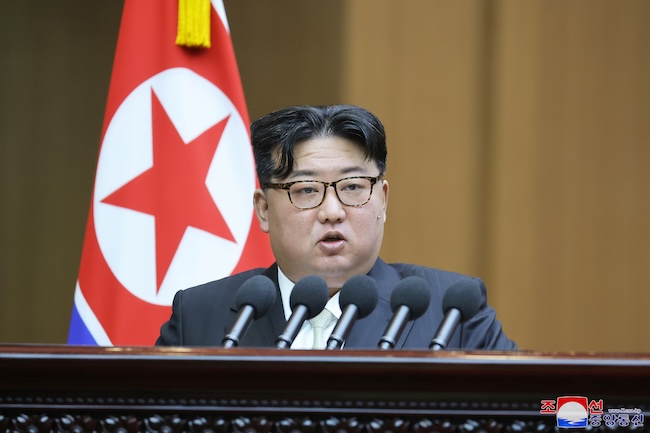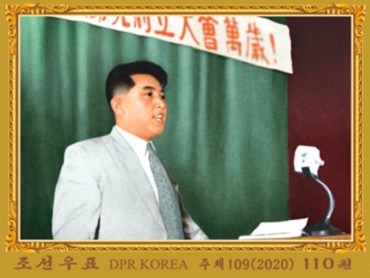
This photo, carried by North Korea’s official Korean Central News Agency on Jan. 16, 2024, shows the North’s leader Kim Jong-un delivering a speech at the 10th session of the 14th Supreme People’s Assembly held in Pyongyang the previous day. (Image courtesy of Yonhap)
WASHINGTON, Jan. 29 (Korea Bizwire) — North Korea’s bellicose rhetoric, persistent weapons tests and pursuit of sturdier military ties with Russia are raising questions over whether it is time for the United States to recalibrate its policy and take a more creative approach.
After taking office in early 2021, the Joe Biden administration unveiled a “calibrated, practical” approach to Pyongyang, put out diplomatic feelers to the intransigent regime and emphasized its readiness to engage in dialogue “anywhere, anytime without preconditions.”
But its approach has been hamstrung by the North’s insular stance in the midst of COVID-19, its deepening distrust towards South Korea and the U.S., and America’s heavy focus on handling more urgent geopolitical challenges, including Russia’s war in Ukraine, observers said.
Calls for Washington to pay more heed to evolving North Korean threats have risen as North Korean leader Kim Jong-un’s rhetoric against Seoul and his regime’s tests of apparent nuclear weapon delivery platforms raised the specter of potential armed conflict on the Korean Peninsula.
Concerns have also been deepening over the dwindling space for diplomatic engagement with the North as Pyongyang has been turning to its traditional partners, Russia and China, in a way that has lessened its appetite for diplomacy with the U.S. or the South.
The Biden administration is credited with strengthening deterrence efforts with Seoul and Tokyo and tightening the enforcement of U.N. Security Council resolutions, but North Korean threats have continued unabated.

This photo, carried by North Korea’s official Korean Central News Agency on Jan. 29, 2024, shows the North’s firing of a claimed submarine-launched cruise missile the previous day. (Image courtesy of Yonhap)
“It’s unfortunate the U.S. government doesn’t seem to have any creative North Korea policy besides finger wagging,” Josh Rogin, a columnist, wrote in an op-ed on The Washington Post published Thursday. “The Biden administration has bolstered ties with (and between) Japan and South Korea, but alliance management is hardly sufficient.”
At the start of the Biden administration, questions lingered over whether its approach toward the North would be a replica of a “strategic patience” approach that commentators said was pursued by the former Barack Obama administration.
Strategic patience refers to the U.S. waiting patiently until the North shifts towards denuclearization while heaping pressure on it through sanctions, diplomatic isolation and other measures.
The Biden administration’s repeated dialogue overtures to the North under the “no-hostile-intent” mantra helped ease worries about the potential revival of a strategic patience approach, but concerns have reemerged amid a recent rise in tensions on the peninsula.
“I think the Biden administration’s approach is inadequate because it hasn’t adjusted to address North Korea’s new posture, and it has already demonstrated itself ineffective in changing North Korea’s behavior,” Frank Aum, a senior expert at the United States Institute of Peace, told Yonhap News via email.
“Of course, the Biden administration argues that it is engaging seriously, beyond just rhetoric, by reaching out numerous times to North Korea to engage but to no avail.”
Aum described the Biden administration’s stance on the North as one similar to the Obama administration’s second-term “pressure-based” approach that “used diplomatic isolation, economic sanctions and military deterrence measures.”
During Obama’s first White House term from 2009-2012, his administration sought to engage with the North — an endeavor that led to the 2012 “Leap Day” deal under which the U.S. agreed to offer nutritional aid in return for Pyongyang’s moratorium on nuclear and missile tests. But his policy took a shift after the deal broke down due to the North’s subsequent rocket launch.
“Biden is maintaining the pressure-based approach, but he is open to talks ‘without preconditions,’” Aum said. “But of course, there are preconditions in Biden’s approach — i.e., denuclearization has to be on the agenda, and talks have to start at the working level to demonstrate that North Korea is serious — and North Korea is not interested in meeting those preconditions.”
Commenting on Biden’s approach to the North compared with Obama’s formula, Patrick Cronin, Asia-Pacific security chair at the Hudson Institute, took note of changes in the security, political, and geostrategic landscapes in recent years.
Those changes involve Washington’s navigation through a change from the former liberal South Korean government to the current conservative one, and ascendant competition with China and Russia, which Cronin said keeps North Korea as a “lower priority.”
Against the backdrop of growing instability in the Middle East and other policy headaches, the Biden administration appears to have focused largely on “managing the status quo” when it comes to North Korea, Nam Chang-hee, political science professor at Inha University, said.
“The U.S. does not want to see a major clash on the peninsula flare up,” Nam said. “And North Korea may have expectations for how things will unfold should former President Donald Trump return to the White House.”
Nam was referring to Trump’s presidency during which the former president sought leader-to-leader diplomacy with the North Korean leader, which led to three in-person meetings between them though serious negotiations stalled following their no-deal summit in Hanoi in 2019.
While the rise in tensions on the peninsula has drawn renewed attention to the U.S.’ policy approach forward, views on whether tension would spiral into a bigger conflict varied.
The debate on the possibility of war picked up pace after Robert Carlin, a former North Korea analyst at the Central Intelligence Agency, and Siegfried Hecker, a renowned American nuclear scientist, recently said they believe the North Korean leader has decided to “go to war.”
“That may sound overly dramatic, but we believe that, like his grandfather in 1950, Kim Jong-un has made a strategic decision to go to war,” they said in a joint contribution to 38 North, a U.S. website devoted to analysis about North Korea.
But others differed.
“I think there are many rungs to the escalation ladder that North Korea could climb short of war,” Victor Cha, senior vice president for Asia and Korea Chair at the Center for Strategic and International Studies, said.
“I would expect they would do that before going to all-out war. Having said that 2024 will be a year of many North Korean military demonstrations/ provocations,” he added.
To chart a path for de-escalation at a minimum, experts called for more proactive diplomatic efforts.
“Instead of just preparing militarily, the U.S. and ROK should shift their approach so that they emphasize diplomacy,” Aum said. “Right now, the alliance has a very narrow focus on deterrence and is ignoring all the diplomatic tools in their toolkit.”
ROK stands for South Korea’s official name, the Republic of Korea.
(Yonhap)






